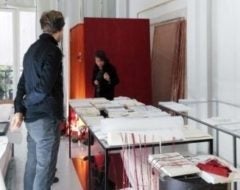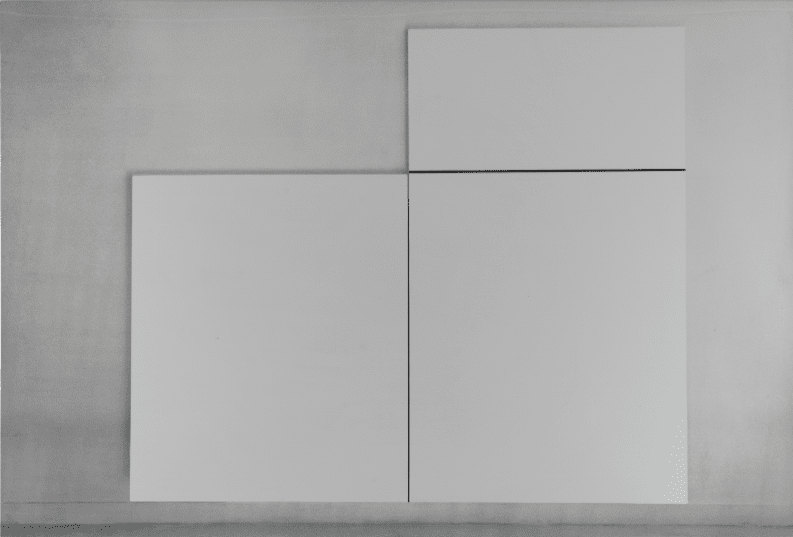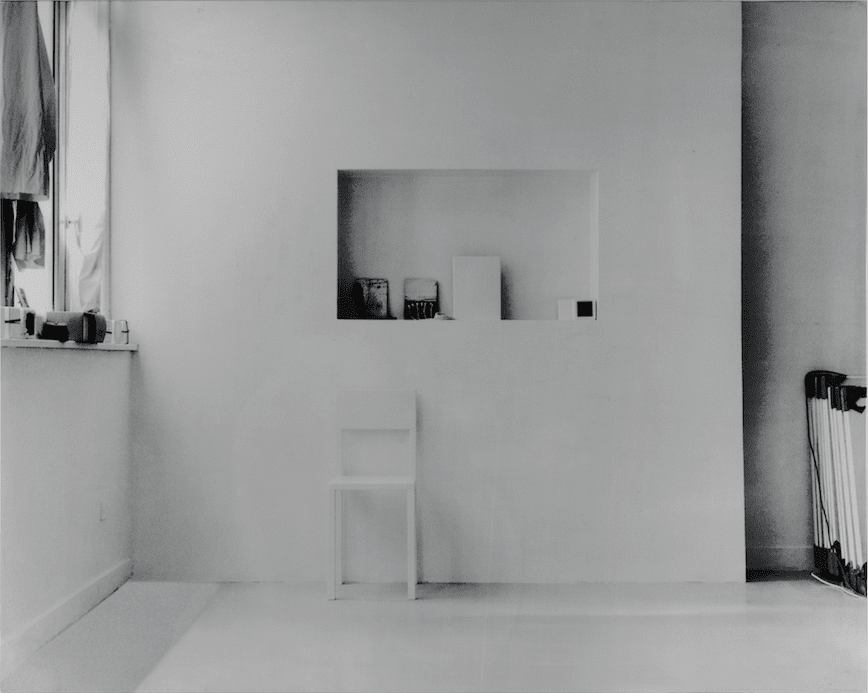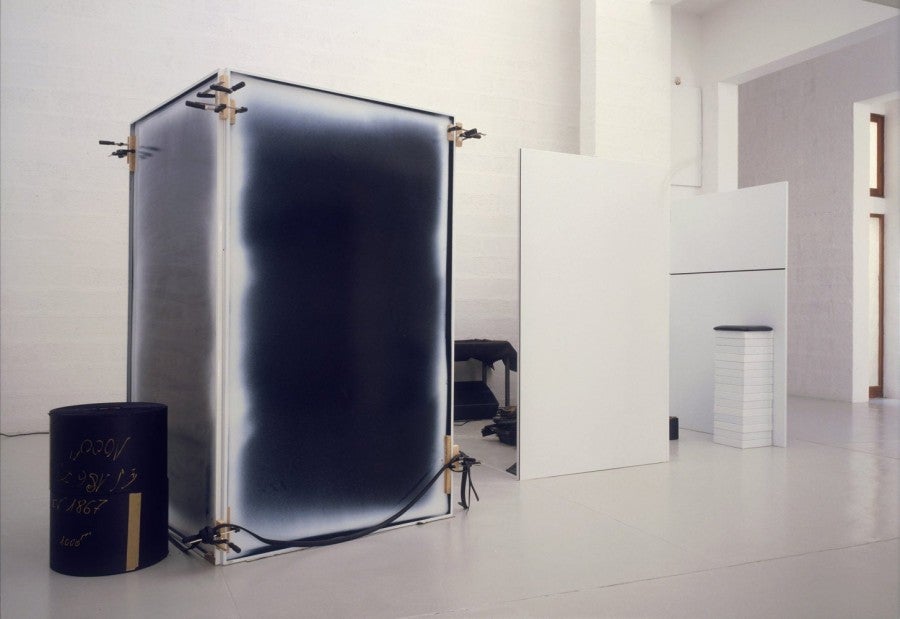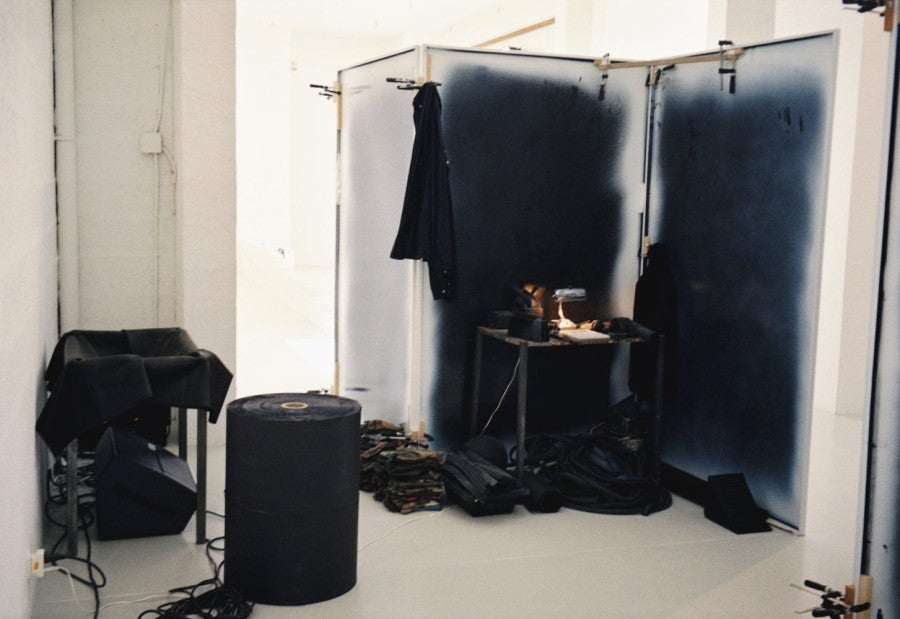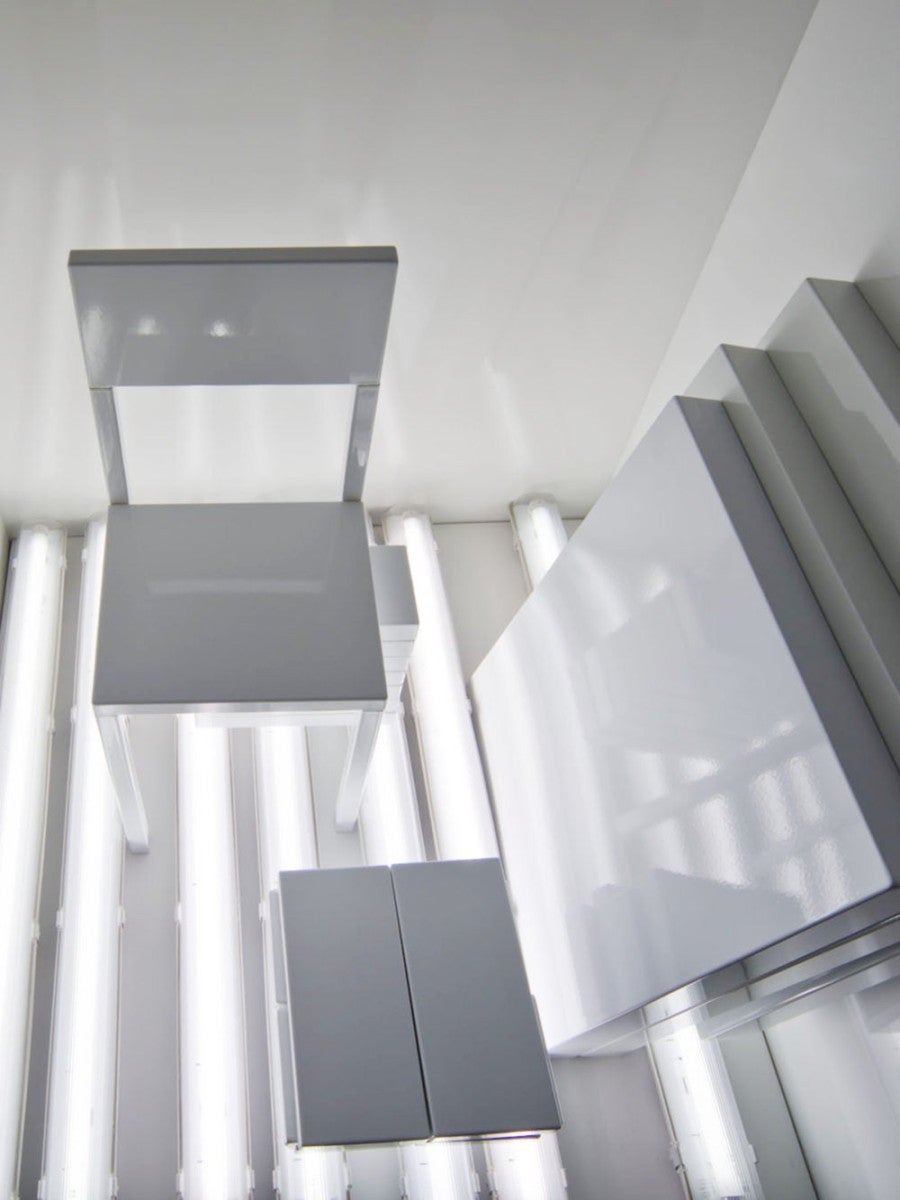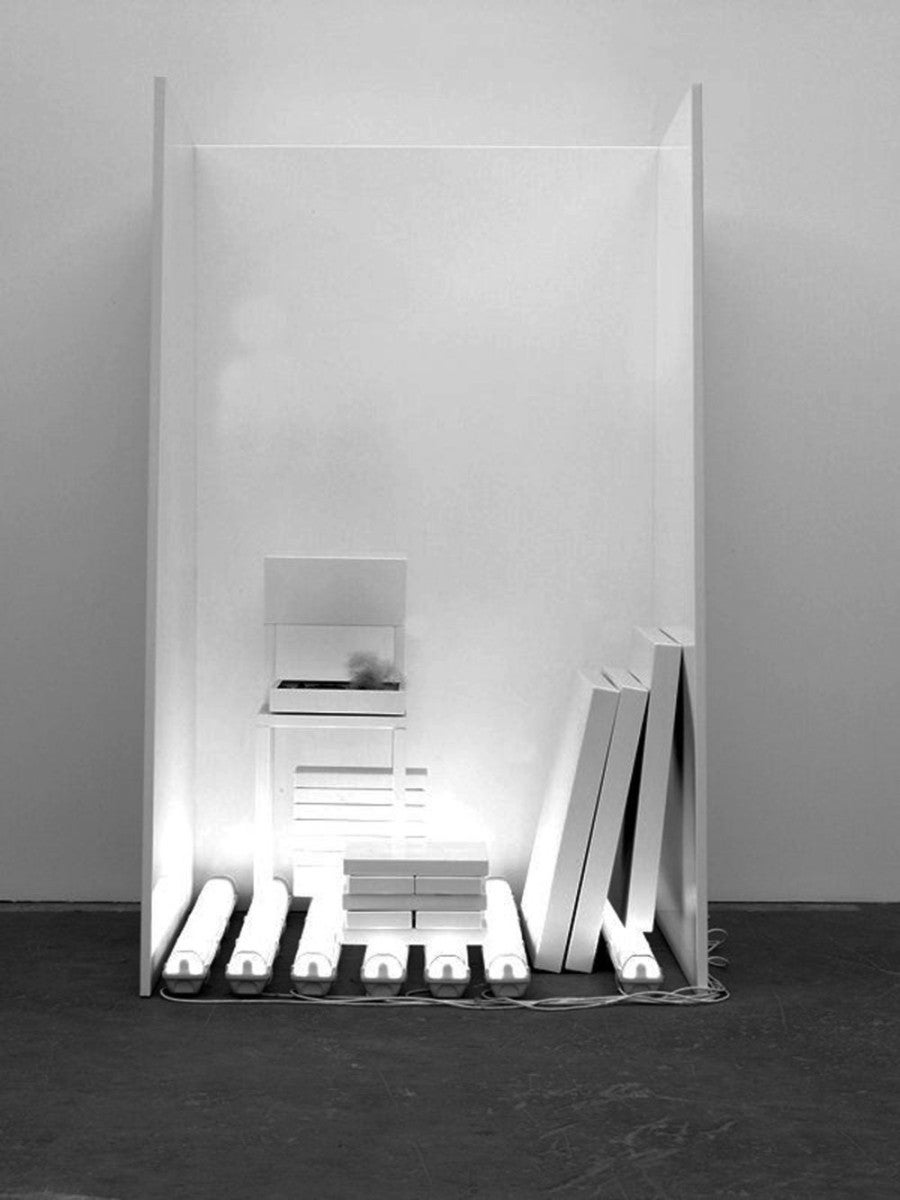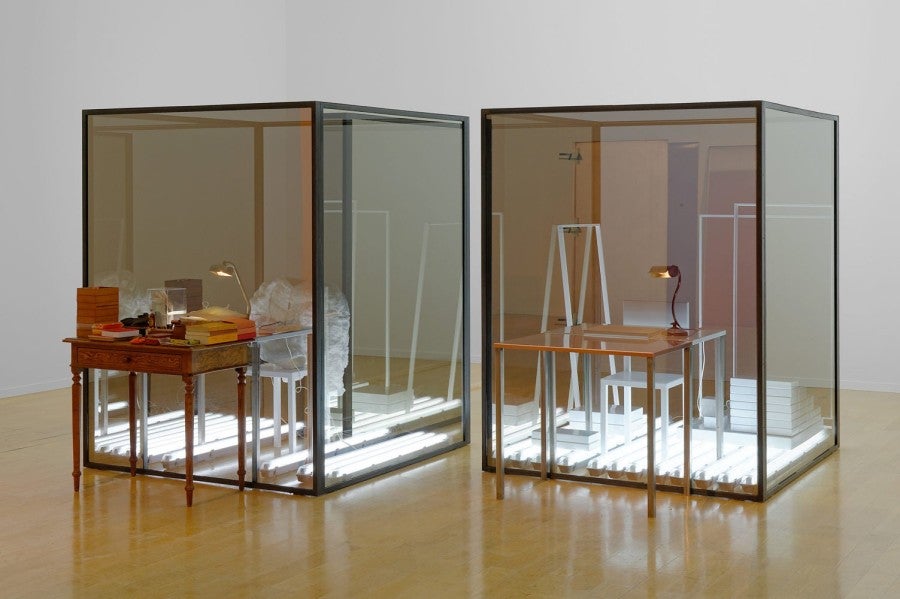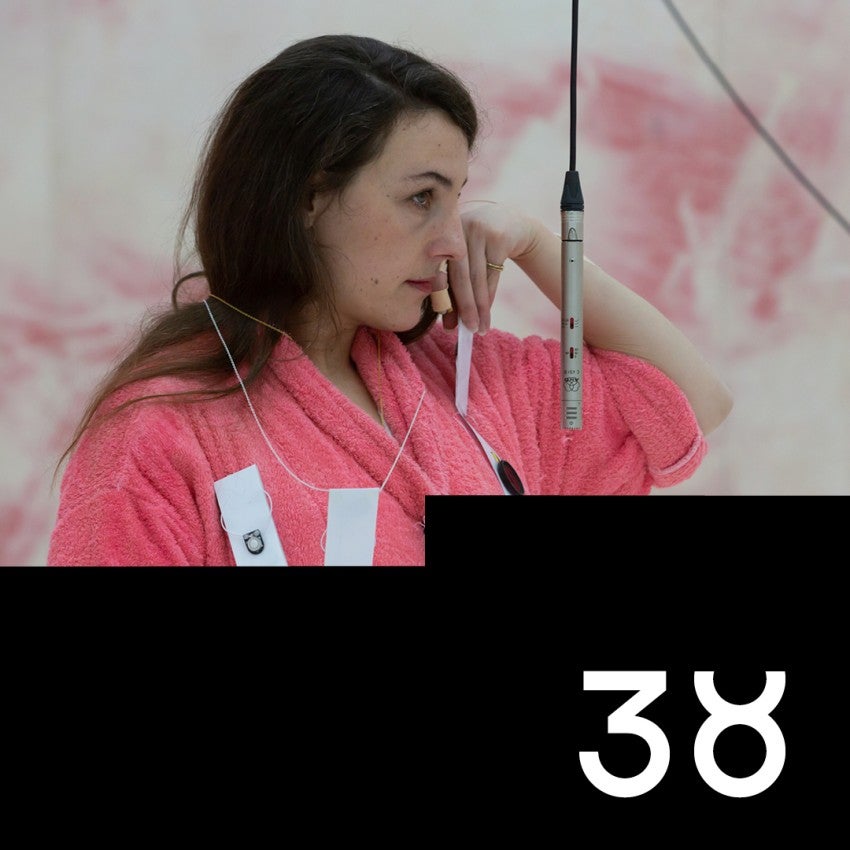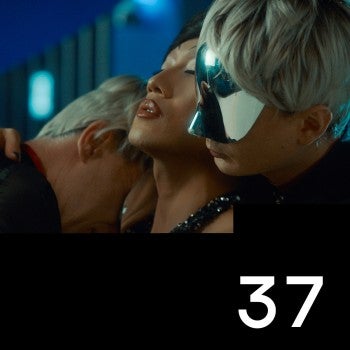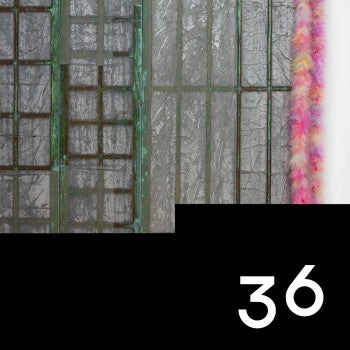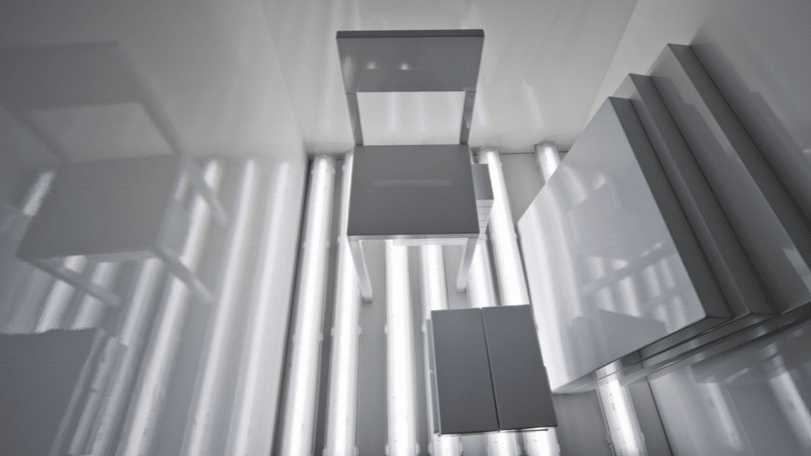
Laura Lamiel has been making work now for five decades. So in ways, the recent presence of her work in international contexts, or at least the inclusion of her work in biennials and her representation by young galleries with broad exposure, amounts to a rediscovery. That a private foundation in France has joined with the French Ministry of Culture in commissioning a text on Lamiel’s work – this fact alone gives some indication of what’s changed; if not in Lamiel’s work, then around it. It also suggests that Lamiel’s work has been underserved by writing in particular. So one of the things this essay will do is look at past writing about Lamiel’s work. It will at times spiral around or away from Lamiel’s work, because it could be said to lack context; it’s sometimes understood as being apart from its historical context, and in at least one case, it stands in complex relation to the discursive context proposed by an author: Anne Tronche, a French art critic and later employee at the Ministry of Culture who engaged with Lamiel’s work over many years. Hopefully, tracing this arc will allow us to speak both broadly and specifically about Lamiel’s production.
Laura Lamiel was born in Morlaix, in northwest France, in 1948. She attended art school in France in the 1960s, and she dates the origin of her practice to 1978. As any of the essays written about Lamiel can tell you, the artist made a breakthrough in 1985, when she started working with steel coated in white enamel. She first formed that material into ‘bricks’ with a standard measure of 15 x 33 x 4 cm in 1989, and the element has been a mainstay of her work in three dimensions ever since. Previous to that, Lamiel had been singularly preoccupied with painting and in search of a zero point in monochrome that made Robert Ryman seem like an obstacle. Since the mid 1990s, though, Lamiel’s work has largely consisted of small, walled-in spaces or delineated fields like tables, often incorporating white enamel. She populates these architectonic frames with found objects, personal effects, photographs, and drawings she’s made. (The objects have changed over time, as we’ll see.) White enamel, which originally served as a means to explore her interest in light, white, and the limits of painting, later enabled her to “transgress the limit beyond which a painting is no longer a painting and becomes an object in its own right.1” These words, written by French art critic Anne Tronche, were meant to apply to the artist Donald Judd. Still, “it is to this genealogy of works that Laura Lamiel’s own works clearly belong,” according to Tronche.2
We might speak to the complex dynamic pairing 'inside' and 'outside' in Lamiel's work...
Anne Tronche’s essay “La pensée du chat”, originally published in a book of the same name accompanying Lamiel’s 2000 exhibition at Crestet Centre d’art, was – for a time at least – the most penetrating take on the artist’s work.3 A year later, “La pensée du chat” was reprinted both in French and in English translation in a catalogue produced by Diana Lowenstein Gallery.4 In the preface to the later version, Tronche begins by reflecting on the function of the catalogue essay: to provide an overview on an artist’s work. But, she writes, a catalogue essay also has a drawback, « uprooting as it does the exhibited works from their context […] and, as a result, hemming in the exhibits within a space-time which is restricted and can no longer allow one to bear in mind significant parameters”5 One of those parameters, Tronche proposes, is the origin of the artist’s materials. Another is the exhibition site, which can dictate how viewers encounter works. Tronche mentions that some artworks are conceived to exist in situ – meaning for and only ever in one specific place – implying that Lamiel belongs to this genealogy as well. But this is not entirely accurate.
Historians have argued that attention to the specificities of a site, its architecture, and the way it frames works stemmed from Donald Judd’s era. Viewers’ awareness of the space around a Minimalist sculpture, the time in which they’re viewing it, and their own bodily presence can be seen as a precedent for a work’s reflecting, in literal terms, the conditions of a site. And in “La pensée du chat”, Tronche quotes the preeminent French figure in this artistic genealogy, Daniel Buren. For him, “in situ […] means that [a work’s] link to the site is restraining and, conversely, that it influences a lot the place where it is. »6
And yet, what’s original about Lamiel’s work when seen in relationship is her maintenance of a conventional studio practice; she would often make work that was not in anticipation of a specific exhibition, and thus not in response to a specific space. Whereas Buren described his “distrust of the studio and its simultaneously idealizing and ossifying function”7 and insisted that all his work “proceeds from its extinction,”8 Lamiel would go on to develop a decades-long studio practice that, at least recently, has seen her artmaking extend into the kitchen and bedroom of her live/work studio.9 What’s more, she’s made works that have existed entirely within the confines of her studio. Although familiar anti-conceptualist rhetoric might suggest Lamiel’s studio practice somehow debunks Buren’s project, one might instead ask how someone as perceptive as Tronche could invite such an apparent contradiction in terms. Or, in exploring that disconnect, we might speak to the complex dynamic pairing ‘inside’ and ‘outside’ in Lamiel’s work: She was both ‘inside’ and ‘outside’ this artistic genealogy as well as the quite unique French art system of the time; her works look and thus expand both ‘inwards’ and ‘outwards’.
There’s a body of work within Lamiel’s production that I find particularly telling, and which I hope might make some of these operations clear: Between October 1993 and June 1996, Lamiel realized a series of works that she then documented photographically in an artist’s book. Or, I should rephrase: The French text describes the book as “calling to mind » a series of arrangements (installations in French) realized by the artist. Over the more than two and a half years during which Lamiel didn’t have any solo exhibitions, she set up, photographed, and broke down a number of ‘works’ in her studio. Many were never exhibited; many no longer exist. The photos of the arrangements also cast the artist’s studio as a kind of ‘ideal’ environment, in that it’s removed from outside circulation. Many of the ‘works’ went through their entire life cycle there. The series and the accompanying book were titled Avoir lieu, meaning “to take place” – as in, viewers may not have seen and might never see these installations; still, they existed for a time. They blur the distinction between an original, its reproduction photographically, and later versions. What’s telling is that while this ambiguity has a substantive meaning within Lamiel’s output – in that her work deals directly with some of these issues – that same ambiguity relates to, or was at times prompted by, her experience. Had she received more invitations to exhibit, each of the arrangements in Avoir lieu might exist separately and in reality. As is, they function as a kind of loose matrix for her work, in that she later reproduced them in installations, printed them on baryta paper, and silkscreened them onto enameled steel. So you could say that Lamiel’s work responds to or relates to its framing, sure, but then that response is not necessarily discursive, nor explicit.
A Personal Language
Before getting into historical context, let’s look at how authors have written about Lamiel’s work. This might reveal what’s helpful to talk about when it comes to Lamiel’s work and what isn’t. For example, writers have frequently implied a vague connection between Lamiel’s work and language, though that can be misleading – as for many years, Lamiel’s work rarely included text. Her works – objects, installations, photographs – almost never contained words that added up to semantic sense, letters that combined to form words, let alone written symbols of any kind. A significant exception may prove the rule: Though three recent tabletop sculptures include pieces of printer paper scrawled with red ink, pages that she’d used as scratch paper, her handwriting is illegibly small, morphing instead into pointillist clouds. (The works, titled Forclose (2017), present stacks of white clothes, boxes, and papers, and under the table, dyed-red strings draw lines hanging down to a mirror underneath; the underside of the glass tabletop is foregrounded, visually, to the same extent as the top surface.) But through into the early 2000s, Lamiel’s works were often if not mostly untitled, and she has almost never published any of her own writing.10 When I asked Lamiel’s most regular, longest-running conversation partner, art historian Jacques Leenhardt, whether Lamiel’s work isn’t somehow pre-lingual, he replied, “I’d even say it’s without language.” (This may have changed, as her titles have recently become rather poetic.) All the while, a frequent motif in writing about Lamiel’s work has concerned her ‘vocabulary’, her ‘personal language’, her ‘sculptural language’ – perhaps because, in the absence of verbal or written language, Lamiel has long presented a material language, or a formal one.
If the elements don't have any kind of stable, internal meaning, is her work purely formal?
In terms of those found and sometimes bought objects framed by her work: Into the 1990s, they came primarily from the streets of Paris. They included “metal trolleys, sheepskins, tapis de caniveaux – rolls of coarse fabric used to direct the flow of water in Paris gutters – boilermaker’s gloves, stained, damaged, visually ‘noisy’”.11 The objects have an undeniable sense of materiality and reference, but their associations are usually limited to generalities such as ‘work’ or ‘the street’. Essentially, these found objects are catalysts for projection within the meticulously fabricated, architectonic framing devices. Writing in 2015 and quoting Lamiel, writer Marie Cantos called these objects contraires, meaning ‘opposites’.12 “Gradually,” though, Cantos writes, these “markers from the outside world” (another phrase borrowed from Lamiel), were “supplanted by markers for a more personal, inner world.” The latter included “furry cacti, migrants’ suitcases, covered books, canvas jackets, steel plates from the artist’s ‘library’.”13 But how, you might ask, were those representative of a more personal, inner world? An example: It turns out the suitcases in Passageway, one of Lamiel’s works for the 2016 Biennale de Rennes, are filled with leather jackets originally worn by the artist, but which she no longer wanted. She literally filled an artwork with things from her own life. Still, this isn’t something viewers would have known. The suitcases remained closed. So, the sense in which they are “more personal” may be just that: a sense viewers have. And the “inner world” they come from may be just that as well: closed off to viewers – personal, maybe, but not biographical in any accessible way.
This begs the question, if the elements don’t have any kind of stable, internal meaning, then is her work purely formal? Although Lamiel speaks about her installations succeeding when they set up a sense of tension among their elements, between each other in space, in relation to the exhibition space, and in viewers’ experience of the works, she identifies her central interrogative as “Are we communicating?” The content of that communication may be beside the point. Viewers encounter a relentless investigation of materials and Lamiel’s use of them to reach viewers; we witness a play between what she would call ‘realities’ as well as a complex testing of representation. Take the aforementioned photos from Avoir lieu as an example or the wall-mounted, enameled steel works from throughout the 2000s silkscreened with images of Lamiel’s works from the early 1990s.
The inconstancy of what’s right in front of us is something that writers have tried to put into words. In the abovementioned text, Cantos says that each ‘cell’ – a common architectonic framing device in Lamiel’s work, though the same could be said of other works of hers as well – “teems […] with memories of past arrangements, potential alternative arrangements of the things we see before us, and incipient re-arrangements to come.”14 But this “slippage” (Cantos), has not been easy for others to describe, at least in passing, or even necessarily to conceive of, as many writers have preferred alluding to the work’s ‘metaphysics’. It’s a word used by Lorand Hegyi, writing in his capacity as Director of the Musée d’Art Moderne de Saint-Étienne, in his forward to the catalogue accompanying Lamiel’s show there, in 2013. Rather casually, he also mentions the work’s ‘metaphors’, its ‘poeticism’, and its ‘logic’ – without explaining which metaphors, which poetics, or what logic. Lamiel, for her part, hasn’t been particularly helpful in clarifying these terms, nor outspoken about the terminology she would prefer for her work. Instead, as Tronche’s brief text in the Saint-Étienne publication makes clear, “In Laura Lamiel’s art, the thinking behind the works is not discursive […] What language makes concrete here is the tension between juxtaposed elements, the danger of moving from one vocabulary to another.”15 I interpret that as a reference to the difficulty of applying language to Lamiel’s work, one of the reasons I’ve opted to look closely at the writing that already exists.
Tronche first presented that essay as a lecture in a competition organized by France’s International Association of Art Critics. The exhibition and the catalogue were the result of her winning. In this way, Tronche’s essay points to something else: Her support of Lamiel’s work – even if Lamiel at times lacked professional opportunities. In addition to writing extensively and importantly about Lamiel’s work, Tronche was an employee of the French Ministry of Culture in the Department of Artistic Creation from 1982 to 1999, so she must have been involved in the acquisition of works by Lamiel.16 Even if other artists received significantly more support than Lamiel did, this system was still part of the historical context. Since the contemporary cultural landscape is one thing Tronche doesn’t address in her published writing on Lamiel – despite her stated fear of “uprooting […] works from their context” – let’s continue with Tronche and see where that takes us.
Anne Tronche
Anne Tronche was ten years older than Laura Lamiel, and in 2012’s L’art des années 1960, she described the nineteen-sixties as “the years in which I first discovered art.” “I ask myself,” she wrote, “to what extent certain interactions had a determining influence on me, on what I chose to write about as well as the way in which I conceived my relation to art criticism.”17
Tronche first published an essay on Lamiel’s work in 2000. In 1997, Tronche authored a short book on performance artist Gina Pane; in 1999, a monographic essay on American painter Peter Saul. Might her interest in these three artists suggest they have something in common? What’s more, might Tronche, in this way, offer a pathway for opening up new connections for Lamiel’s work? Regarding Pane, Tronche was convinced of the work’s urgency: “Over time, certain artists’ works seem, more than others, to embody their era, to translate those parameters that are most secret, those intellectual energies still in formation.”18 Pane, Tronche argued, may have used metaphor, but she made certain aspects of her time and the world clearly understandable. She was “far removed from art that was purely formalist.”19 Tronche, it appears, was critical of purely formalist art, and she may well have disagreed with writers who, well into the early 2000s, implied that Lamiel’s work is no more than an investigation into the medium of painting and its limits with other media.20
In writing about Peter Saul, Tronche offers not only vivid descriptions of his formal operations, but also a concrete lineage of influence: from Francis Bacon, who greatly inspired Saul; via Matta, who helped connect Saul to gallery representation; to several “young artists, primarily in France and Italy,”21 who learned about Saul’s work during the years the artist spent in Paris. Tronche argues for the influence – evident, yet which “must be evaluated not in any direct way” – that Saul had on both Narrative Figuration and Figuration Libre artists. This lineage provides the framework within which Tronche considers Saul’s work over time. Ultimately, her thesis has less to do with shifts in his work and more to do with the rich sense of connection between Saul and younger artists.
It wouldn’t be possible to write about Lamiel in this way. ‘Direct’ or not, Lamiel’s practice hasn’t involved significant exchange with other artists or with discourse – except for one collaboration with Cécile Bart at their shared gallery, Anton Weller in Paris, in 1998. This aligns with what we already know about Lamiel’s works at times rotating within the universe of her studio, or perhaps registering an experience that viewers can’t access. Still, let’s assume for a moment that this quality is neither just personal, nor the result of her studio practice, nor necessarily unique to her. After all, in researching this essay, I often read about or heard people describe a degree of isolation as characteristic of contemporary art in France during the 1980s and 1990s. One could cite, here, any number of texts expressing dissatisfaction with the French art system, which was much-discussed in those years. That debate first paralleled a revolution in policy, then a retrenchment. Even if Lamiel isn’t the best representative of that system, it might be a roundabout way of considering whether the nature of Lamiel’s practice might somehow account for its position – disconnected or at odds with both its historical and its discursive context (or at least the one offered by Tronche), yet now apparently possessing some acute contemporary relevance.
Art in France
In terms of that debate: The title of French historian Philippe Poirrier’s essay “French Cultural Policy in Question, 1981–2003” is indicative. In it, Poirrier recounts the shifts in policy – during the most formative decades of Lamiel’s career – that began with the election, in 1981, of French president François Mitterand and his implementation of a socialist cultural policy. His new Minister of Culture, Jack Lang, would command a budget that had doubled in size and “the unswerving support of the President.”22 According to Poirrier, this led to the adoption of two parallel policies: “giving citizens at large access to works of culture […] and extending welfare benefits to the artistic community.”23But by the late 1980s, the policy had come under attack. Some thought it flaunted essential hierarchies within the arts by funding “rock music, fashion, advertising, etc.”24 And in 1990, a study revealing the persistence of “material and symbolic barriers restricting access to ‘high’ culture” within French society – despite the ministry’s efforts to democratize culture – was “interpreted as proof that [they] had failed.”25 Critics argued that the ministry should instead limit itself to preserving cultural heritage. Then, following the return to power of the right in 1993 and the establishment of a policy of cultural exception in the face of globalization, which was accused of “snuffing out […] traditions, languages, cultures and knowledge,”26 private patronage appeared as a potential solution. By 2003, the Minister of Culture and Communication would speak out approvingly of patronage – but we’ll get to that.
Shortly before, in 2000, then one year after she’d left the Ministry of Culture, Anne Tronche reflected on the ministry’s work in writing. In a catalogue celebrating more than twenty years of the regional fund for contemporary art in Burgundy, she touched on shifts in sentiment during her tenure. And she distilled the debate over public support for contemporary art down to one question, Was taxpayer money well invested? That said, Tronche’s essay clearly serves to affirm the choices made by Burgundy’s regional fund. The vast majority of her essay consists of ambassadorial language confirming the fund’s efforts; the primary method she uses to evaluate the ministry’s mission is historical shorthand. In reference to one exhibition, she writes that, in order to convince readers the right artists were selected, “it will suffice to mention a few names.”27The issue, however, was more complex than Tronche gives on. What about, for example, the one-off funds offered to some French artists experiencing financial hardship? The mere existence of such funds suggests an interest in artists’ well-being as well as artists’ professional success, and thus in the success of the system. This concern is never made explicit in the French Ministry of Culture’s yearly reports from the 1980s and 1990s, which summarize their activities. Nor is it addressed in a later publication such as Trésors Publics : 20 ans de création dans les Fonds régionaux d’art contemporain (Public Treasures: 20 Years of Creation in the Regional Funds for Contemporary Art). Despite the fact that all three participants in an interview introducing that book acknowledged the widespread debate concerning the ministry’s efforts, the question of the system’s efficacy went unaddressed. So Lamiel may not have been the greatest beneficiary of the state’s support; still, it’d be worth asking, generally, to what extent the support ensured artists’ success on an international scale.
To return to Poirrier’s essay: He’s surprisingly aloof about the French government’s increasing reliance on patronage to support contemporary art, a trend that has of course continued. Given, it falls just outside the limits of his focus – namely, governmental policy. Instead, for more detail, one might look to the genealogy to which Anne Tronche argued Laura Lamiel belongs. In the mid-to-late 1980s and again in the early 1990s, one particular artist in this lineage generated significant attention in France: Hans Haacke. And though no direct connection exists between Haacke and Lamiel, the presence of his work in contemporary discourse must have motivated Tronche, in part, to write about Lamiel’s work in the way she did. For Haacke, “The context in which a work is exhibited for the first time is a material for me like canvas or paint.”28 And in 1986, he made his first work in relation to French material. Following a visit to the Fondation Cartier pour l’art contemporain, where he saw an exhibition by Jean-Pierre Raynaud – interestingly, an artist who Lamiel would like to see her work connected to – he made Les must de Rembrandt, about Cartier’s parent company. As art historian Yve-Alain Bois explained, Haacke’s works from this era “expose the desire of [companies like Cartier] to be positioned as liberal and generous sponsors of cultural activity, while establishing the connection between this desire and these corporations’ actively pro-apartheid policy in South Africa.”29 Then, three years later, Haacke continued his focus on industry’s use for culture through his solo exhibition at the Centre Georges Pompidou in Paris. In his preface to the accompanying catalogue, he recounted the views of Cartier’s president on supporting art: “Private patronage is not simply a formidable tool for communication; it is much more than that: It’s a tool for seducing opinion.”30 In this way, Haacke spoke directly to the changing French art system, revealing the contingencies of art’s increasing reliance on private funding. This offers a clear contrast to how Lamiel deals with site, and it draws the historical context closer to the present.
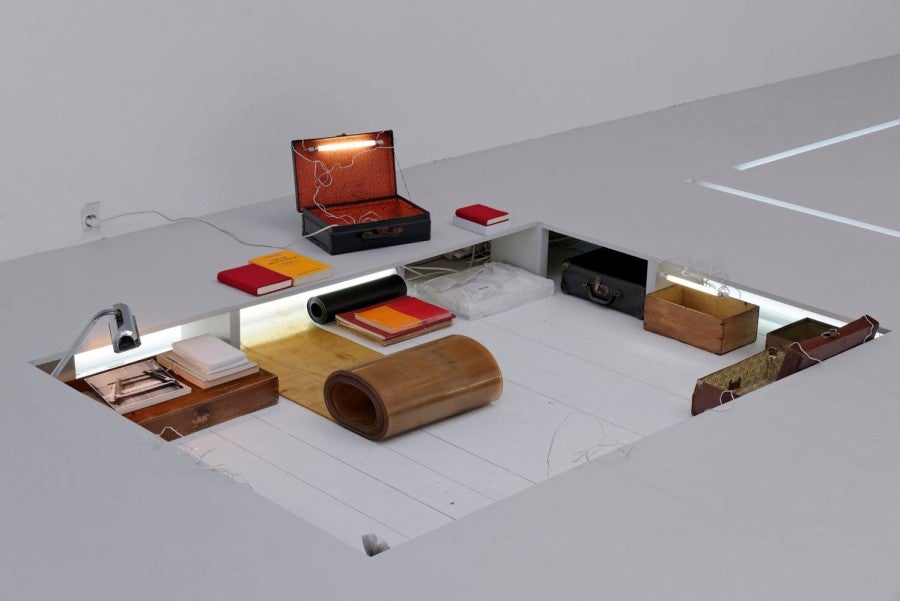
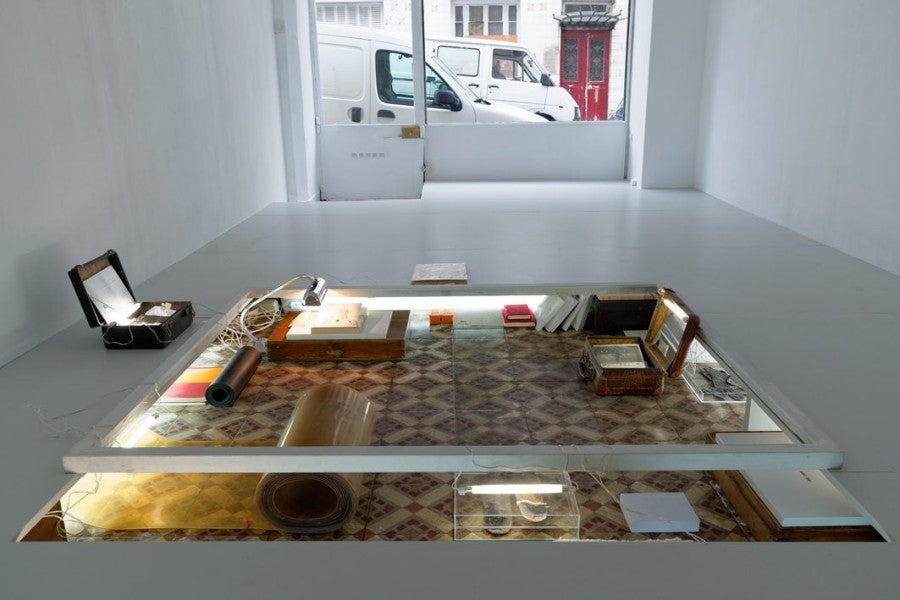
Return to the Studio
That sense of anachronism may be exactly what lends Lamiel's work its contemporary relevance...
So we find ourselves back at the question of how Anne Tronche could frame Lamiel’s work within a genealogy of in situ, or site-specific art and discourse, though her work seems so disconnected from that context. It seems clear that Tronche’s text was overdetermined, perhaps exactly because of the nature of Lamiel’s work; its openness to outside frames and to viewer associations. Still, we know that even if Lamiel’s work didn’t speak directly about the French art system or her experience within it, that frame is also somehow ‘inside’ the work. What’s more, one could even argue that the work’s openness is something it shares with subsequent artists’ works that reflect on their site in some way, but without possessing a traditional, deconstructionist intent. The apparent anachronism, if not of Lamiel’s work in its historical context, then in its discursive context – that sense of anachronism may be exactly what lends Lamiel’s work its contemporary relevance, or at least that’s the outlook proposed by French curator François Piron when I spoke with him.
Piron is one of several people from later generations who have promoted Lamiel’s work recently. Historical distance, he and I discussed, may be exactly what allows us to accept the diversity and even contradiction presented by art, history, and discourse. Piron, for his part, suggests seeing Lamiel’s work in relation to a contemporary of hers, artist Tania Mouraud. Even if their works diverge formally, Piron rightly points out the time that both Mouraud and Lamiel have spent in India. And Lamiel’s interest in Buddhism is something that has so far gone unexplored in writing about the artist; it would account for her color palette, among other things. For her part, Isabelle Alfonsi of Marcelle Alix, Lamiel’s gallery in Paris since 2013, mentioned something Lamiel shares with a younger artist like Tatiana Trouvé. Alfonsi sees an obvious comparison in terms of aesthetics, materials, and color palette. What’s more, she says, space is reconstituted in Trouvé’s work as well, and in the process, the work becomes a kind of maze. But Alfonsi also notes that these two women artists’ careers have progressed very differently, and she wonders to what extent that reflects structural changes, both in art and in general. Lamiel’s former Berlin gallerists, Dominic Eichler and Michel Ziegler of Silberkuppe, point out similarities with Israeli-French artist Absalon, who lived in France in the late 1980s and early 1990s, prior to his death in 1993. Absalon even showed one of his all-white architectonic ‘cells’ at the Musée d’Art Moderne de la Ville de Paris in 1993. Although viewers can enter Absalon’s cells, Eichler and Ziegler describe them as claustrophobic; Lamiel’s are human-size and filled with objects that try to grab viewers’ attention, but we’re not allowed to enter. Her cells protect their privacy, in a way.
I can’t help but wonder about the relation between Lamiel and an artist like Joëlle Tuerlinckx, or French artists like Christian Boltanski and Annette Messager – both from Lamiel’s generation – or even Louise Bourgeois, not only formally but also in terms of recognition arriving late. But I’m also skeptical about relatively arbitrary, indirect references, as if the right name or the right number of them will amount to context for an artist who hasn’t really engaged with other artists or with discourse. What’s more, even if a given reference seems to offer some degree of clarity or legitimacy to Lamiel’s work – and again, I sympathize with the impulse – each is also always incomplete, so it invites another. Instead, the historical context presented here, while also incomplete – a fact, by contrast, that is telling – that context might nevertheless be a way around the dead end of arbitrary connections and the hermeticism they, unfortunately, do little to resolve.
I’ll conclude with an aspect of Lamiel’s work that may yet reflect, in a general way, on systemic concerns: Over time, while Lamiel has continued to use her signature white, enameled steel in constructing walls for her ‘cells’ and ‘houses’, she also began incorporating reflective, semi-transparent, and transparent surfaces. Some cells have walls made of mirrors, others of spy glass, and still others of clear glass. Not only do such surfaces prompt a degree of self-awareness on the part of viewers, since we either see ourselves or see others viewing, such surfaces also suggest a new kind of openness in Lamiel’s work. Viewers can see from outside Lamiel’s cells in, and they can see the exhibition architecture either through or pictured in the work itself. I’d also imagine that the symbolism of transparency is not lost on an artist whose materials are her primary language. It may be no accident that these materials appeared when Lamiel was once again prompted to participate in gallery exhibitions, in biennials, and in new conversations with those from younger generations.
Two-way mirrors form the walls of ‘Vous les entendez…‘ (‘You hear them…’), first exhibited at the Lyon Biennale in 2015. Two ‘cells’ stand separate, but together. Each includes a desk that is partly inside and partly outside, spliced by the front wall. The parts of the tables inside the cells are made of enameled steel; outside, one is wood, and one is copper. Inside, the cells are cold from white fluorescents and white, enameled steel. Outside, the materials are organic, warm. The inside is in a way ‘ideal’, geometric, sterile, cerebral. The forms are the product of Lamiel’s imagination, and she fabricated them herself. Lamiel is building a bridge between her imagination and its manifestation in the exhibition space, and she is reflecting on that bridge. She’s also emphasizing that connection by doubling the cells. The work makes us conscious of that presence of mind, but also suggests access to its inner workings. Lamiel herself would say her work is an investigation into the limits of reality. She is asking, here, what reality is, and elsewhere – for example when she offers alternate versions of an installation or a photographic reproduction of one – she’s asking which one is reality. Ideally for her, these poles, like the two cells of Vous les entendez…, exist in relation to and in tension with one another. Rather than speaking explicitly about what’s above or around them, Lamiel’s installations may consist exactly of what’s in front of us – both what’s inside and what’s outside of them; what we have access to and what we don’t, though her works, recently, appear to be opening up in ways. Lamiel’s works may consist of everything they touch on when they’re “in tension,” as she says.
Anne Tronche, “La pensée du chat,” in Laura Lamiel (Miami: Diana Lowenstein Gallery, 2001), p. 9.
Ibid.
The title, borrowed from one of Lamiel's works, was translated into English as “The Cat's Thoughts”.
Lamiel was represented by this Miami gallery for a short period in the early 2000s, and between 2001 and 2003, they showed her work a handful of times in the United States as well as at Art Basel in Switzerland.
Tronche, “La pensée du chat,” p. 3.
Ibid, p. 33–34.
Daniel Buren, “The Function of the Studio,” trans. by Thomas Repensek, in October, vol. 10 (Autumn 1979), p. 55.
Ibid, p. 58.
In conversation with the artist, December 2017.
She selected quotes by various authors for the broadsheet accompanying her exhibition at La Verrière (Fondation d’entreprise Hermès) in 2015. She's published at least two interviews, both brief. And her “Présentation du travail”, or artist's statement, is almost exactly fifty percent quotes from Tronche's “La pensée du chat”.
Marie Cantos, “Please, Now, Close Your Eyes,” in Laura Lamiel: Chambres de Capture (Brussels: La Verrière (Fondation d'entreprise Hermès), 2015), p. 15.
Ibid.
Ibid.
“Please, Now, Close Your Eyes,” in Ibid, p. 15.
Anne Tronche, “The Becoming-Sense of the Sensitive,” in Laura Lamiel (Milan: Silvana Editoriale, 2013), p. 59.
The online collection of the Fonds national d'art contemporain, housed at the Centre national des arts plastiques, lists eight works by Lamiel, all but one of which date from the 1980s and 1990s.
Anne Tronche, L’Art des années 1960 : chroniques d’une scène parisienne, Paris, Hazan, 2012, p. 7.
Anne Tronche, gina pane : actions, Paris, Fall Edition, 1997, p. 7.
Ibid, p. 12.
See, for example, Arnauld Pierre's essay “Peinture/matériel” in the 2000 catalogue, titled reConnaître : Laura Lamiel, from Lamiel's exhibition at Musée de Grenoble.
Anne Tronche, "Peter Saul, inventor," in Peter Saul (Paris: Somogy, 1999), p. 46.
Philippe Poirrier, “French Cultural Policy in Question, 1981–2003,” in After the Deluge: New Perspectives on Postwar French Intellectual and Cultural History (Lanham, MD: Lexington Books, 2004), p. 395.
Ibid, p. 398.
Ibid, p. 402.
Ibid, p. 403.
Ibid, p. 416.
Anne Tronche, “Faire voir, absolument,” in Fonds régional d'art contemporain de Bourgogne : 1984–2000 (Dijon: Frac Bourgogne, 2000), p. 19.
Yve-Alain Bois, “The Antidote,” in Hans Haacke, ed. by Rachel Churner (Cambridge, MA: MIT Press, 2015), p. 75.
Ibid, p. 73.
Hans Haacke, “Communication,” in Artfairismes (Paris: Editions du Centre Pompidou, 1989), p. 6.
